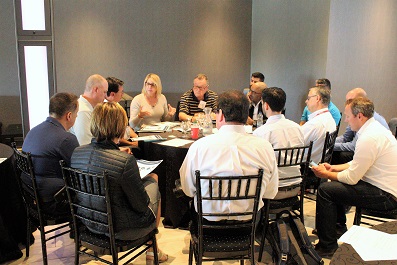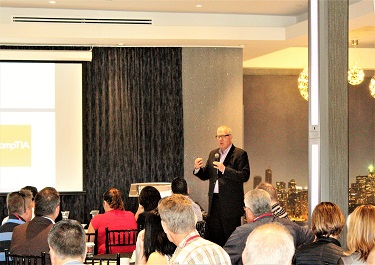 Innovation, strategy, and sales methodologies have at least one thing in common: they each mean something different today than they did a decade ago. In the IT services community, the complexity and speed of change can be overwhelming to providers, vendors and distributors today — and delays and simple mistakes can have major repercussions.
Innovation, strategy, and sales methodologies have at least one thing in common: they each mean something different today than they did a decade ago. In the IT services community, the complexity and speed of change can be overwhelming to providers, vendors and distributors today — and delays and simple mistakes can have major repercussions.
Members of the CompTIA Canadian IT Business Community deal with those same challenges, and brought three professionals to this week’s meeting to share their expertise and advice. Not only did they offer valuable insight in their targeted presentations, but each subject matter expert hosted a topical workshop session to dig deeper into the issues.
Building for the Future
First up on the agenda was Sherry Colbourne, President and CEO at Spark Centre with an overview of technology-related advances and the methodologies behind their development. Many started with a simple idea and came to fruition through grassroots efforts, not projects funded by corporations with deep pockets.
Spark was designed to offer entrepreneurs that type of assistance. As one of several RICs (Regional Innovation Centers) in Canada, Colbourne and her team provide a co-working environment, expert business and development advice, and a strong network of professional connections. “There are a variety of ways to get involved, all we ask is that they show up and kick the tires.”
She shared several examples of innovations developed with various RIC resources, including Awake Labs’ bracelet for kids with autism. The wearable and its accompanying app measure and track anxiety levels in children so parents can note behavioral changes and prevent them from having meltdowns.
Roster Point is another example of innovation, a disruptive online community for hockey players and teams. “It is somewhat like a community marketplace, but not as simplistic. It uses a comprehensive algorithm to score and rank players objectively.”
Colbourne used these cases to show community members the resources that are available to entrepreneurs in Canada. Those with innovative ideas should consider having a discussion with their local RIC representatives.
Execution is Crucial
The next expert to present was David Barrett, President of Solutions Network. He started with the reality that many corporate strategies fail. But why? In most cases, it comes down to execution of their vision. “The future state just wasn’t clear. A strategic plan needs clarity and it has to be addressed continually. I this really the plan and is this working? As the owner, I may be committed, but it won’t work unless everyone else who is critical to its execution in on board.”
Leadership is crucial, and many companies —not just IT firms — struggle in that area. Barrett listed off a number of big business failures in Canada to emphasize how often plans fall apart due to misreads and missteps by the management team. From grocery chain Sobeys’ botched acquisition of Safeway to Yahoo previous decisions to pass on buying Google or Facebook, the results don’t often meet expectations.
“There are times when you take a stab and it doesn’t work, no matter how good the plan and how well it’s executed. The critical issue is having the resources to make it happen and keeping personal feelings out of the way. There have been many acquisitions, mergers and launches where the sole reason for their failure was one person’s ego.”
Barrett made several recommendations to achieve strategic success, including:
- Provide clarity: goal and responsibilities must be easy for key players to understand. Where are you going and why? What does it look like?
- Get commitment: is everyone on board? If not, they may need to be replaced.
- Accountability- are all team members given responsibilities, timelines and held to specific performance standards?
- Create a culture of execution: it truly takes a village to ensure plans work out. Set high expectations and incentivize people accordingly.
A New Sales Model
 Rick McCutcheon, President of Full Contact Selling highlighted a major shift in his presentation to the community. “Sales and prospecting have become multidimensional. Cold calling or hunting is a smaller part of the process now that the buyer is in control.”
Rick McCutcheon, President of Full Contact Selling highlighted a major shift in his presentation to the community. “Sales and prospecting have become multidimensional. Cold calling or hunting is a smaller part of the process now that the buyer is in control.”
He emphasized that point with a list of the ways companies generate leads and interact with potential clients today, including (this is just a sampling):
- Chat
- Web tracking
- Lead scoring
- Nurture Marketing
- SMS messaging
Full contact selling looks like a pinball machine — with prospects being hit with a variety of different marketing and engagement activities. Millennials are forcing some of these changes. They tend to search for products and services on mobile devices and use chat as a primary form of communication. Web sites and selling methods have to be adapted. Channel firms that don’t offer chat functionality and the latest communications platforms may find themselves on the losing end of new sales opportunities…and not even know it.
Sales management techniques are changing, too. “You have to be part artist and part scientist to succeed today. Sales leaders need to be creative and analytical, with the ability to track performance and make changes that improve lead close rates and other measures of success.”
They key for channel firms is to continually adapt themselves and their processes. Hunters still have a role in most sales organizations, but the focus continues to shift to content marketing and improved lead nurturing processes.
Change was a common theme in the CITB discussions. Channel companies have to adapt to new buying preferences, and improve their resource utilization. Doing more with less will be a frequent topic of business discussions in 2017, and the CompTIA CITB Community will likely bring in similar experts to lead those types of conversations in their future meetings.




0